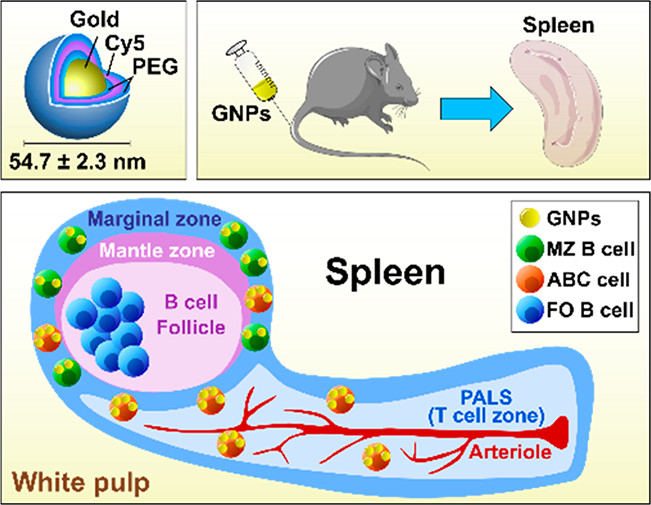PEGylated Gold Nanoparticles Target Age-Associated B Cells In Vivo
Summary
Engineered gold nanoparticles (GNPs) have become a useful tool in various therapeutic and diagnostic applications. Uncertainty remains regarding the possible impact of GNPs on the immune system. The authors of this article, led by GCIR member Professor Carole Bourquin and published in ACS Nano, investigated the interactions of polymer-coated GNPs with B cells and their functions in mice. Surprisingly, they observed that polymer-coated GNPs mainly interact with the recently identified subpopulation of B lymphocytes named age-associated B cells (ABCs). Importantly, they also showed that GNPs did not affect cell viability or the percentages of other B cell populations in different organs. Furthermore, GNPs did not activate B cell innate-like immune responses in any of the tested conditions, nor did they impair adaptive B cell responses in immunized mice. Together, these data provide an important contribution to the otherwise limited knowledge about GNP interference with B cell immune function, and demonstrate that GNPs represent a safe tool to target ABCs in vivo for potential clinical applications.
Why is this important?
Among other fascinating applications, gold nanoparticles (GNPs) are used as drug carriers, and can serve as a platform for vaccine delivery. The administration of GNPs conjugated to antigens of various pathogens has shown significant enhancement in the adaptive immune response. This is due to the preference of B lymphocytes to phagocytose particulate antigens, which significantly enhances antigen presentation to T lymphocytes and leads to efficient activation of cellular and humoral adaptive immune responses.
However, as the number of biomedical applications of GNPs increases, questions are being raised about their safe use in humans; therefore, numerous studies have been conducted to evaluate the potential toxicity of GNPs and their adverse impact on the immune system. Polymer coating of GNPs is a common practice to increase the level of biocompatibility and stability. In particular, coating with polyethylene glycol (PEG) improves the half-life of GNPs in the blood as it prevents the formation of an external protein corona. However, it has been reported that PEG-coated nanomedicines are not fully resistant to opsonization with plasma proteins, such as immunoglobulins and complement proteins, which may lead to receptor-mediated immune responses.
In this article, the authors demonstrate that polymer-coated GNPs are well tolerated and do not affect the innate or adaptive immune response in vivo. Furthermore, they investigate how polymer-coated GNPs interact with B lymphocytes in different organs and different immune cell subsets in mice. Age-associated B lymphocytes (ABCs) are a subset of B cells that play a role in various contexts, such as ageing, response to microbes, and autoimmunity. The authors observed significant selective uptake of GNPs by ABCs in this study, which means that GNPs can be used as a tool to specifically target ABCs due to their unique association properties, highlighting future research approaches and clinical applications of GNPs. For example, to produce more effective vaccines in the elderly, where ABCs constitute a significant fraction of splenic B cells and traditional vaccines are less effective, GNPs could also be used to target ABCs in autoimmune diseases.
This work has been supported by the Swiss National Science Foundation (SNSF), the National Centre of Competence in Research “Bio-Inspired Nanomaterials” and the Adolphe Merkle Foundation.
Full article: https://pubs.acs.org/doi/10.1021/acsnano.2c04871

